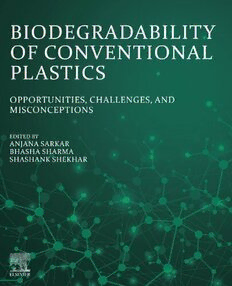
Biodegradability of Conventional Plastics: Opportunities, Challenges, and Misconceptions PDF
Preview Biodegradability of Conventional Plastics: Opportunities, Challenges, and Misconceptions
Biodegradability of Conventional Plastics Biodegradability of Conventional Plastics Opportunities, Challenges, and Misconceptions Edited by Anjana Sarkar Department of Chemistry, Netaji Subhas University of Technology, Delhi, India Bhasha Sharma Department of Chemistry, Shivaji College, University of Delhi, India Shashank Shekhar Department of Applied Science and Humanities, Faculty of Technology, University of Delhi, Delhi, India Elsevier Radarweg29,POBox211,1000AEAmsterdam,Netherlands TheBoulevard,LangfordLane,Kidlington,OxfordOX51GB,UnitedKingdom 50HampshireStreet,5thFloor,Cambridge,MA02139,UnitedStates Copyright©2023ElsevierInc.Allrightsreserved. Nopartofthispublicationmaybereproducedortransmittedinanyformorbyanymeans,electronicor mechanical,includingphotocopying,recording,oranyinformationstorageandretrievalsystem,without permissioninwritingfromthepublisher.Detailsonhowtoseekpermission,furtherinformationaboutthe Publisher’spermissionspoliciesandourarrangementswithorganizationssuchastheCopyrightClearance CenterandtheCopyrightLicensingAgency,canbefoundatourwebsite:www.elsevier.com/permissions. ThisbookandtheindividualcontributionscontainedinitareprotectedundercopyrightbythePublisher (otherthanasmaybenotedherein). Notices Knowledgeandbestpracticeinthisfieldareconstantlychanging.Asnewresearchandexperiencebroadenour understanding,changesinresearchmethods,professionalpractices,ormedicaltreatmentmaybecome necessary. Practitionersandresearchersmustalwaysrelyontheirownexperienceandknowledgeinevaluatingandusing anyinformation,methods,compounds,orexperimentsdescribedherein.Inusingsuchinformationor methodstheyshouldbemindfuloftheirownsafetyandthesafetyofothers,includingpartiesforwhomthey haveaprofessionalresponsibility. Tothefullestextentofthelaw,neitherthePublishernortheauthors,contributors,oreditors,assumeany liabilityforanyinjuryand/ordamagetopersonsorpropertyasamatterofproductsliability,negligenceor otherwise,orfromanyuseoroperationofanymethods,products,instructions,orideascontainedinthe materialherein. ISBN:978-0-323-89858-4 ForinformationonallElsevierpublicationsvisitourwebsiteat https://www.elsevier.com/books-and-journals Publisher:MatthewDeans AcquisitionsEditor:AnaClaudiaA.Garcia EditorialProjectManager:SaraGreco ProductionProjectManager:KameshRamajogi CoverDesigner:MatthewLimbert TypesetbyTNQTechnologies About the editors Anjana Sarkar Anjana Sarkar, Head of Department and Professor, Department of Chemistry, Netaji Subhas University of Technology, Delhi, India Prof. Anjana Sarkar is currently Head of the Department of Chemistry at Netaji Subhas University of Technology. With 37 years of teaching and research experience at Netaji Subhas University of Technology, she has published various papers in national and international journals. Prof. Sarkar completed an AICTE sponsored R&D project on ‘Ternary Complexes of Transition Metal Ions with Novel Biomolecular like Kojic Acid & L-Amino acid: Synthesis & Study of Physicochemical Properties and their Bio-efficacy’, and has been awarded “Woman of the Year 1998” by the American Biographical Institute, North Carolina, USA. Affiliations and Expertise Professor and Head of Department, Department of Chemistry, Netaji Subhas University of Technology, Delhi, India Bhasha Sharma Bhasha Sharma is an Assistant Professor in the department of Chemistry Shivaji College, University of Delhi, India. She received her BSc (2011) in Polymer Sciences from the University of Delhi. Dr. Sharma completed her Ph.D. in Chemistry in 2019. Her research interests revolve around sustainable polymers for packaging applications, environmental benign approaches for biodegradation of plastic wastes, fabrication of bionanocomposites, and finding strategies to ameliorate the electrochemical activity of biopolymers. Affiliations and Expertise Assistant Professor, Department of Chemistry, Shivaji College, University of Delhi, India Shashank Shekhar Shashank Shekhar Assistant Professor, Department of Chemistry, Netaji Subhas University of Technology, Delhi, India Dr. Shashank Shekhar is currently an Assistant Professor at Netaji Subhas University of Technology and is also associated with the Quantum Research Centre of Excellence as Associate Director in the Department of Renewable Energy. He completed his PhD in Chemistry at the University of Delhi. Dr. Shekhar has been working on biopolymers and Schiff base metal complexes for the last 5 years and has published articles in reputed international journals. Affiliations and Expertise Assistant Professor, Department of Chemistry, Netaji Subhas University of Technology, Delhi, India Contents CHAPTER1.Lifecycleassessmentandenvironmentalimpactofplasticwaste Introduction Lifecycleassessment Definitionoflifecycleassessment Fateofplasticsintheenvironment Movementofplastictrash:fromland toaquaticecosystem Effectofplasticdumpingonaquaticecosystem Environmentalimpactofvariousplasticproducts Majorrepercussionsofplasticwaste Globalproductionofplasticsandgenerationofwaste Managementofplasticwastes Recommendationstoreduceandcontrolplasticwastes Futuredirectionsandrecommendations Conclusions References CHAPTER2.Composition,propertiesandotherfactorsinfluencingplastics biodegradability Introduction Microbialdegradationofplasticmaterials Mechanismsofbiodegradation Microorganismsinvolvedinbiodegradation Theplastisphereandfuturepossibilities Plastic-degradingenzymes Influenceofplasticpropertiesonbiodegradation Polymericcomposition Molecularproperties Additivechemicals Influenceofenvironmentalandexternalparametersonplasticbiodegradation Temperature SalinityandpH Dissolvedoxygen Pressure SunlightandUVexposure Moistureandhumidity Fragmentationandtransportofpolymersinthemarineenvironment Adsorptionofpollutantstoplasticdebris Biodegradationpotentialsinmarineenvironments Marinemicro-andmacrofaunainvolvedinplasticdegradation Ghostfishing Challengesandmisconceptions Conclusions,knowledgegaps,andfutureresearch References CHAPTER3.Bioplastics,biodegradableplastics,anddegradationinnatural environments Introduction Typesofplastics Syntheticplastics Bioplastics Bioplasticsclassification Biobasednonbiodegradableplastics Fossil-basedbiodegradableplastic Biobasedbiodegradableplastic Challengesofstarch-basedbioplastics Hydrophilicity Mechanicalproperties Processabilityofstarch-basedmaterials Solutionsforstarch-basedbioplasticchallenges Improvementinhydrophilicproperty Improvementinmechanicalproperty Improvedprocessability Thermalstability Problemstatement Methodology Preparationofstarchbiobasedplasticfrombananapeels Preparationoffiller Degradation Typesofdegradation Conclusion References CHAPTER 4. Bioplastics overview: are bioplastics the panacea for our environmental woes? Introduction What are bioplastics? Could bioplastics tackle the issue of natural plastic accumulation? What are the likely environmental dangers of using bioplastics? What is the capacity for bioplastics to tackle pollution caused by conventional petroleum-based plastics? Disposable plastic items Agricultural application (biodegradable plastic mulch film) High-end market What are the opportunities and difficulties of using bioplastics? Conclusion References CHAPTER 5. Generation and impact of microplastics and nanoplastics from bioplastic sources Introduction Bioplastics: sources and sinks Bioplastics market Biobased polyethylene Biobased polypropylene Biobased polyethylene terephthalate Biobased polyvinyl chloride Polylactic acid Cellulose acetate Microplastics: sizes, forms, and manufacturing Nanoplastics Distribution of microplastics Aquatic environment Terrestrial environment Fate of microplastics and nanoplastics Quantification of microplastics and nanoplastics Visual sorting Spectroscopic techniques Fourier-transform infrared spectroscopy Raman spectroscopy Thermal degradation Mitigation of microplastics and nanoplastics Health impacts of microplastics and nanoplastics Knowledge gaps and key directions Conclusion References CHAPTER 6. Biodegradability of synthetic plastics: effective degradation mechanisms Introduction Market growth of synthetic polymers and challenges in degradation Synthetic polymers and biodegradation by microbial species Biodegradation of polyethylene Biodegradation of polystyrene Biodegradation of polyvinyl chloride Factors affecting the rate of biodegradation Role of enzymes in biodegradation Tests for assay of biodegradation of synthetic polymers Conclusion References Further reading CHAPTER 7. Biodegradability of polyolefins: Processes and procedures Introduction Oxo-biodegradation mechanism of polyolefins What is biodegradation? Enhanced polyolefin biodegradation Blending and mixing Pretreating with external conditions Incorporation with polymer nanocomposites Introduction to microbes and microbial products Genetically modified microorganisms Programmed biodegradation and its consequences Future trends Conclusion References CHAPTER 8. Biodegradability and current status of polyethylene terephthalate Introduction Synthesis and properties of polyethylene terephthalate Polyethylene terephthalate: applications and environmental impact Mechanism of polyethylene terephthalate biodegradation Polyethylene terephthalate-degrading microorganisms Actinomycetes Algae Bacteria Fungi Ideonella sakaiensisdthe polyethylene terephthalate specialist Polyethylene terephthalate-hydrolyzing enzymes Bioeconomy of polyethylene terephthalate biodegradation and bioproduction Recent advances in polyethylene terephthalate production and degradation Future prospects References CHAPTER 9. Biodegradability and bioremediation of polystyrene-based pollutants Introduction What are the forms of polystyrene? Why are polystyrene-based pollutants so hard to biodegrade? Biodegradability of polystyrene-a review of known methods Microorganisms (fungi, bacteria, and archaea) in biodegradation Larvae in biodegradation Invertebrates in biodegradation Plastic depolymerizing enzymes Advantages and implications of PS biodegradation Future perspectives References CHAPTER 10. Biodegradability of Polyvinyl chloride Introduction Types and properties of PVC PVC waste and environmental challenges PVC disposal methods Physical treatment Chemical treatment
